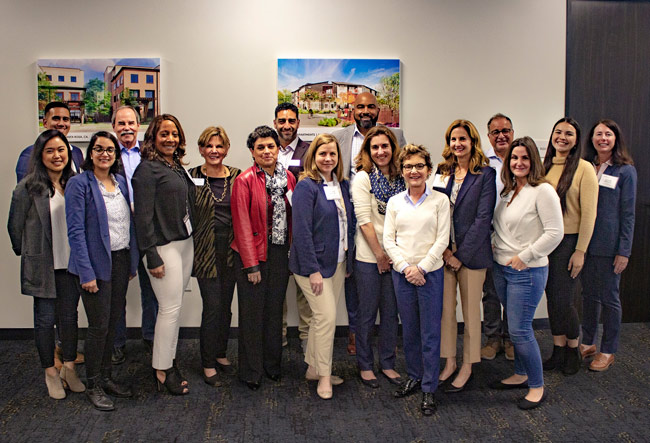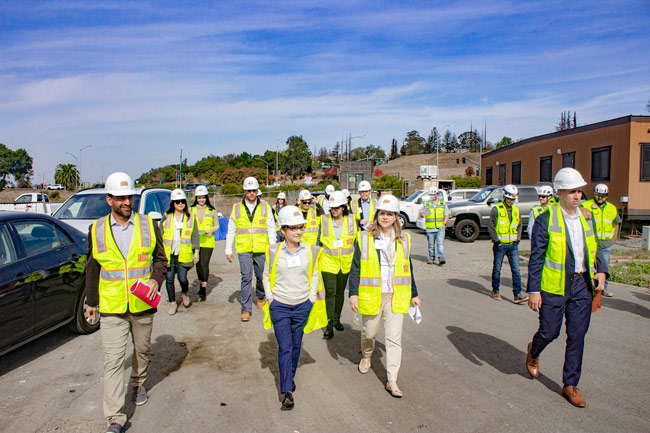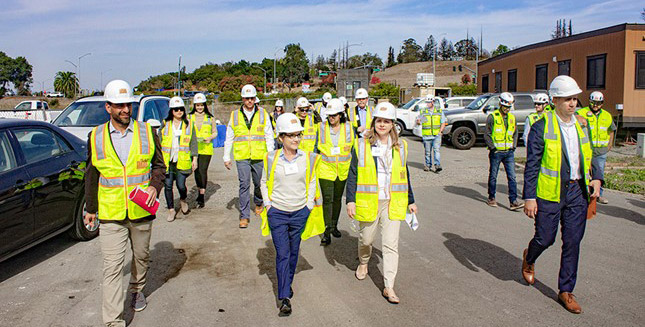In October 2017, the Tubbs Fire devastated 36,807 acres of Napa and Sonoma Counties in northern California, including 2,834 homes, mostly located in the city of Santa Rosa. The disaster caused significant housing displacement in a community that was already experiencing increasing housing costs and limited affordable housing opportunities. At the time, it was the most destructive wildfire in California’s recorded history.
The Community Development team engages with multisector partnerships to expand economic opportunity—including in the aftermath of disasters. In the wake of the Tubbs Fire, the team held a series of roundtables to facilitate discussions focused on solutions and financing models to support the recovery of the local economy. These roundtables brought together a range of stakeholders and partners, including local community members across Sonoma and Napa counties; nonprofit organizations; financial institutions and Community Development Financial Institutions (CDFIs); local, state, and federal housing and transit agencies; and affordable housing developers.
Together, these community partners put a series of recovery activities into motion. For example, they established the Renewal Enterprise District (RED), a Joint Powers Authority (JPA) formed by the City of Santa Rosa and the County of Sonoma, to accelerate housing and community development that is affordable, located near transit, and energy efficient. Financial partners, notably ones that have not traditionally been involved with affordable housing and community development efforts, also came to the table to provide construction financing.
Rising from the ashes: A new beginning for Journey’s End Mobile Home Park
One neighborhood lost entirely to the Tubbs Fire was the Journey’s End Mobile Home Park, which housed 160 mobile homes plus one manager’s unit. Nearly three quarters of the homes, or 117 units, were damaged or destroyed. Situated at 3575 Mendocino Ave, the 13.3 acre site is now being redeveloped as part of a master planned transit village community led by Burbank Housing, a nonprofit affordable housing developer in the North Bay. In 2018, the site owner and Burbank Housing began to explore potential redevelopment opportunities, and by late 2020, the affordable housing component (Phase I and 2) received full approvals by the City of Santa Rosa.
Burbank Housing and Related California, a mixed-income residential developer, began construction in June 2021 of 162 new units of affordable housing for extremely low- to low-income seniors on approximately 2.5 acres, with 132 units (Phases I and 2) expected to complete construction by summer 2023. Burbank Housing will offer first priority for the affordable units to qualifying former residents of Journey’s End Mobile Home Park who were displaced by the 2017 wildfires.
A market rate developer will also construct up to 370 market rate units on approximately 9 acres of the site. In an area with few multiunit developments, the wildfires created an opportunity to build more dense housing to meet the needs of area residents.
Five years later: A visit to 3575 Mendocino Ave.
Right around the five-year mark following the Tubbs Fire, I arranged a visit to the site at 3575 Mendocino Avenue in Santa Rosa in partnership with Burbank Housing. We wanted to see first-hand how the redevelopment is taking shape and to connect with local community leaders to better understand how this wildfire is affected local economic conditions. Governor Michelle Bowman from the Federal Reserve Board of Governors, SF Fed President Mary Daly, Vice President of Community Development Bina Shrimali, and Deputy Chief of Staff Kevin Ortiz joined us to tour the construction site with representatives from the City of Santa Rosa and Sonoma County.

Burbank Housing’s CEO Larry Florin and Vice President of Real Estate Development Efren Carrillo provided details on how the project came together and the conditions that enabled reconstruction following the wildfire. Florin pointed out that the initial roundtables hosted by the SF Fed were instrumental toward engaging key financing partners for the construction of the redevelopment project.
Unmet needs and persisting challenges
The project tour was followed by a roundtable, which included additional community partners from Kaiser Permanente, United Way of the Wine Country, and the Renewal Enterprise District (RED). The group shared thoughtful reflections with Governor Bowman and President Daly about where the community has made progress over the past five years and where unmet needs and challenges still exist.
Community leaders said financing tools and resources remain important to advance recovery and rebuilding efforts. Piecing together the capital stack to develop affordable housing often requires a complex mixture of government and philanthropic grants, state and federal tax credits, and conventional debt. Michelle Whitman, executive director of RED, spoke to the intricacies of attracting and leveraging resources as they work to fill their affordable housing development pipeline. Mr. Florin emphasized the importance of bridging partnerships with financial institutions, especially CRA-motivated banks, to invest in local community development needs like affordable housing.
Looking ahead
Sonoma County Supervisor Chris Coursey, who served as the Mayor of Santa Rosa at the time of the fires, shared a sobering sentiment about how their community must proactively plan for when, not if, the next disaster hits. Responding to an urgent crisis for immediate impact is not enough. Building up for the long-term will require sustained efforts and resources—of which the impact may not be experienced until years later. He also expressed concerns about some of the most vulnerable residents, including extremely low-income households, agriculture workers, and non-English speaking households. Alena Wall from Kaiser Permanente added to this point by sharing how Kaiser is working to understand the most urgent healthcare needs of the communities they serve, especially those who are hard to reach and engage with, and that thorough community needs assessments are vital in shaping policy and planning decisions.
The robust dialogue around the table created a renewed sense of energy and momentum among all of us. It was a reminder of how meaningful conversations serve as a vehicle for change. And that’s what this visit and SF Fed’s Community Development work is all about: bringing people together to promote economic opportunity.

Learn more about this project at Burbank Housing.
You may also be interested in:
- From Legislation to Application: ADUs as a Response to Housing Affordability Challenges
- What We Learned about Residential Instability in the Bay Area during COVID-19
- Investing in Community Infrastructure to Support Thriving Economies
- Wildfire Smoke’s Impact in Los Angeles
- Residential Instability in the City of Oakland and Implications for Data-Driven Policymaking
The views expressed here do not necessarily reflect the views of the management of the Federal Reserve Bank of San Francisco or of the Board of Governors of the Federal Reserve System.

